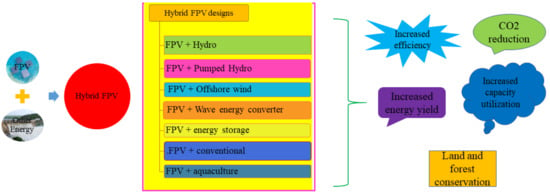Hybrid Floating Solar Plant Designs: A Review
Abstract
:1. Introduction
2. Solar PV in Water Environment
2.1. Floating PV (FPV)
2.2. Underwater/Submerged/Semi-Submerged
2.3. Offshore/Marine Environment
3. Hybrid Floating Photovoltaic System
3.1. Overview of Hybridization
- Grid connectivity (via transmission lines, transformers, and so on) makes the system more reliable.
- Additional source enhances the reliability and productivity of the existing system;
- When used in tandem as a hybrid, water resources, and solar energy can compensate for each other [50].
3.2. Key Drivers of Hybrid FPV
3.3. Classification of Hybrid FPV
3.4. Technological Components of FPV and Hybrid Floating Solar Plants (HFPV) System
- (a)
- Floating structure (pontoon): The PV system is installed on a floating body (floater and structure) in the case of an FPV system [3]. It provides the necessary buoyant force to keep the whole system floating [53]. Floaters are commonly made of high-density polyethylene (HDPE) or medium density polyethylene (MDPE) [54].
- (b)
- Mooring System: The floating structure is held securely with a permanent structure. This halts the free movement of the floating structure in water. The mooring system uses anchors and cables to keep the floating system stable [55]. It can also respond to water level variations while retaining its southward location preventing modules from drifting away or shifting position [56]. A mooring system consists of a mooring string, anchor, and connections and is used to hold a floating platform stationed in any depth of water [57]. An anchor on the seafloor is connected to a floating structure by a mooring line [58].
- (c)
- PV system: Floating photovoltaic (FPV) systems, which are made up of single or multiple crystalline-based photovoltaic (PV) modules [59] mounted on a buoyant platform, are typically intended to be arranged in an array on the surface of a closed body of water. In an FPV system, solar energy is converted into electrical energy using PV modules and other power conditioning equipment [60]. Standard PV modules used in land-based PV systems can be used, but research is being conducted to develop specific flexible PV modules for floating applications [61]. There has been increasing interest in the development of thin film-based solar cells.
- (d)
- Cables and connectors: The electricity generated by the PV system is typically transferred to the substation through underground cables. These cables could be extended underwater or via the floaters, but they could also be used as floating cables [62]. This forms an important link between the grid and the solar panel. Due to its usage underwater cables should be shack proof or leakage proof [63]. The inverters are mounted on the shore side, much like a traditional ground-based system.
- (e)
- Basin: A basin that contains water from the first with a second floating system that serves to bring the same volume of water consumed by the hydroelectric turbines daily through solar pumps, this allows an annual use of the same volume of water without losses.
- (f)
- Other Energy sources: The energy sources like wind, ocean thermal energy conversion (OTEC), hydro, pumped hydro, hydrogen, etc. are considered for the HFPV system.
4. An Overview of Various Designs of Hybrid FPV Technologies
4.1. Floating PV + Wind
4.2. Floating PV + Hydro + Wind
4.3. Floating Solar PV with Pumped Hydro Energy Storage (FPV + PHES)
4.4. Floating + Micro-Hydrokinetic Turbines
4.5. FPV + Wind Energy System and Battery Storage
4.6. FPV with Compressed Air Storage
- The FPV system produces electric energy through PV modules and then supplies to the grid or to the water pump through inverter;
- The water pump compress water, up to 20 MPa in a suitable storage tank where the pressurized water is used to increase the pressure of the air in pipes;
- The compressed air, stored in the floating pipes can be used to power a hydro-turbine to recover the stored energy whenever necessary [24].
4.7. Hybrid Floating Solar + Wind + Ocean Energy System
- Heavy Duty-No Foundation
- Maximum robustness
- Scalability
- Little maintenance
4.8. Floating Solar + Waterlily (Solar Tree) Tracking
4.9. Floating Solar Integration with Conventional Plant
4.10. Floating Solar Island with Hydrogen Energy Storage
4.11. Floating Solar Methanol Island
4.12. Hybrid Floatovoltaic-Aquaculture System
4.13. Floating Photo-Thermal (FPT) + Seawater Desalination
5. Hybrid FPV: Potential, Recent Developments, and Performance Aspects
5.1. Potential
5.2. Recent Developments in Selected Countries
5.3. Industrial Players
5.4. Performance Indicators of Hybrid FPV
6. Positive Implications, Constraints, and Special Consideration of Hybrid FPV
6.1. Positive Implications of Hybrid Floating PV
- It promotes land-use efficiency. Since the floating PV energy systems are mounted on water, the land can be used for other useful purposes [86]. It does not necessitate any land construction or conversion of forest or farmland for solar power facilities [90]. It protects the land’s original uses, such as forests, agriculture, livestock, and nature [91]. Utility-scale solar PV frequently necessitates large parcels of land; however, land-constrained developing countries may have to prioritize land use for agricultural, forestry, or other purposes [92]. By co-locating solar PV systems on artificial water bodies such as reservoirs, FPV may offer alternatives to scaling up renewables and reducing competing land-use pressures [65] A close-to-zero strategy for locating new PV plants without invading natural greenery while also protecting dams from insulation [37].
- Forest and farmland conservation: The main benefit of hybrid FPVs is that they do not require any agricultural or green space. They address the energy-water -land nexus issue. Land use is kept to a minimum. PV modules are installed on the existing water infrastructure (dam, ocean etc), which reduces the amount of land required [93].
- Increased utilization rates of transmission lines / grid access: In general, hydro plants are easily accessible and already connected to the grid, so installing hybrid FPV requires fewer tasks and a power grid [94]. A hybrid system, for example, would save financial resources on transmission by connecting to a common substation [95]. Hydropower sites make use of existing electricity transmission facilities, and they’re close to demand centers (in the case of water supply reservoirs. The hydropower plant’s existing road access likely reduces construction and transportation costs.
- Provides high-energy yield. The increased energy generation is due to the water’s natural cooling effect, which reduces temperature rises in the solar modules [96]. In comparison to a conventional installation on a flat surface, PV panels mounted on an inclined surface, minimizes the distance between two panels and thereby rising solar energy generation [97]. The surface of the water offers areas that are free of shading objects. as well as increased sunlight reflection, which improves PV generation. Due to the cooling action of water and the lack of dust, the energy yield also increases [98].
- Increased capacity utilization. The capacity factor of a hydroelectric power plant is the ratio of the total produced energy to the maximum energy that could be provided. If the hydro plant worked at its maximum installed power capacity all of the time, and floating modules would dramatically increase the installed capacity of a hydroelectric power plant by 50% to 100%. In existing dams, hybrid hydropower-connected F-PV plants (operation of FPV and hydropower together) could offset the loss of electrical production due to variations in water levels [99].
- Saves water resources. Because the floating PV system blocks the sunlight and covers the water surface, it reduces by more than 80% of the evaporation of water in the reservoir [10,68] The hybrid operation of the dams with FPV will enable appropriate and cost-effective management of power and water usage, as well as water savings due to less evaporation from the reservoir [100].
- Uses an eco-friendly system. Natural fish farms may continue to thrive on the platform. They create breeding sites for fish, increase aquatic plants, and reduce algae and microorganism levels.
- Lower capital expenditure (CAPEX): Because of the existing grid infrastructure, hydro-FPV-Hybrid has a lower CAPEX, but it is subject to specific site characteristics. When co-located with hydropower, the power system benefits and capital costs are reduced due to lower interconnection costs.
- Decreased CO2 emissions. The hybrid floating solar farms has a higher potential to reduce the amount of carbon emissions than standard FPV. The HFPV system reduces CO2 emissions per kWh produced, which is especially beneficial in tropical regions.
- Modernization of existing infrastructure. There exists an opportunity to modernize and improve the old infrastructure for the safety, reliability, and performance of the plant [93]. Furthermore, by using the same grid connection, hybrid F-PV and hydropower plants could reduce grid integration costs.
- Operational Flexibility and Dispatchable generation. Plants have the flexibility to operate on-demand with adjustable power output [101]. This is advantageous in countries with a weaker grid as the share of power is extracted from the variable, non-dispatchable solar energy [92,93]. Solar power can be used to boost the energy yield of such facilities while also assisting in the management of low water availability by enabling the hydropower plant to run in “peaking” rather than “baseload” mode, with mutual benefits: Hydropower can smooth out variable solar performance by working in a “load-following” mode [102].
- Dam protection. PV panels protect the dam surface from direct solar radiation, which can weaken the dam’s stability, by reducing thermal excursion and increasing dam stability [72].
- Storage opportunity: Gravity energy storage is naturally indicated by the presence of water, particularly in conjunction with hydroelectric basins [69]. PV energy can be used to power pumps in pumped-storage hydropower plants [71]. In one scenario, hybrid system operators could use pumped storage hydropower to store excess solar generation.
- Increased market potential. This form of combined hybrid FPV plant potential and business opportunities are expected to advance in the future particularly in parts of Asia [104].
- Reducing seasonal variations: Combining floating PV with hydropower has the potential to provide additional benefits [105]. Furthermore, the two technologies can complement one another. During the dry seasons, solar power has the greatest potential., whereas hydropower has the greatest potential during rainy seasons. It can facilitate black-start capabilities for hydro [92]. This is valid not only during the diurnal period (when solar energy is used during the day and hydropower is used at night), but also during the seasons.
- The method of generating power using solar panels kept on water bodies differs from that used on conventional solar farms, where panels are arranged in a rectangular pattern. They have some advantages over land-based systems.
6.2. Constraints and R & D Challenges of Hybrid Floating Technology
- Cost of the technology: Hybrid floating solar installations necessitate specialized equipment which may increase the cost than traditional land-based installations. The costs of floating solar panels are high due to the stringent module requirements, but the costs are expected to fall as technology develops [106].
- Significant water level variation: Water level variations in hydro dams in hot tropical regions (by up to 10 feet) pose a significant technical risk.
- Complex mooring system: The requirement of a complex mooring system for HFPV is a significant limitation. It is unable to withstand heavy high winds, warranting a huge proportion of mooring points to keep it intact [35]. The occurrence of flash floods necessitates careful mooring/anchoring to avoid panel destruction [107].
- Detrimental effects of wind, wave, current, and snow: Microcracks in the solar cells are possible as a result of the constant bobbing movement beneath. Wind, wave, current, and snow have negative effects on the stability and long-term performance of HFPV systems [40].
- Limitation of coverage: The system suffers from the limitation of the water surface that can be covered. Normally 1–10% is covered to reduce environmental impact and Installation restriction on the littoral zone where aquatic life is abundant [108]. The space requirements for leisure and recreational activities pose the challenge of coverage.
- Seasonal variations of weather: The key disadvantage of hydropower-based hybrid FPV is that they are restricted to particular geographical areas. Most hydro plants are used as peaking plants which are highly influenced by monsoon seasons [109]. During some periods of the year, certain reservoirs may be dry or otherwise unsuitable for accommodating hybrid floating PV.
- Joint implementation: The full potential and advantages of joint implementation of the hybrid system are not fully realized by the industry including the operations, scheduling, and optimization.
- Limited experience and knowledge: The current knowledge gap on hybrid FPV systems will inhibit data-driven decision-making. Limited experience with hybrid floating solar/hydropower systems. More specialized installation knowledge is required as this is a unique innovation.
- Larger installations, across different geographies, and over time are needed to validate the extent of these benefits associated, and they can exceed any rise in capital cost in many cases.
- Because of the social and environmental implications of hydropower development, it’s fair to conclude that further application of FPV on dam surfaces would necessitate extensive discussion and review to enforce compliance with societal values [39].
- Lack of guidelines and policies: Inconsistent and very hostile policies for installations are the major drawback of the HFPV system.
6.3. Special Considerations
- Willingness of the FPV owner/developers to add a hybrid installation;
- Development of the right framework and contractual agreement between various parties.
- Concessional agreement between the FPV plant owner/operator and a third party to construct, operate, and maintain an HFPV facility.
- Management of risks and liabilities associated with hybrid power plant and extreme weather that can influence plant performance;
- Rules of dispatch coordination of power from two individual sources (For instance: Floating solar and the hydropower plants’ outputs).
- Creating insurance plans to cover future power plant loss risks.
- IOT based Intelligent monitoring to facilitate the operation, maintenance, and management of the HFPV system.
7. Conclusions and Future Perspective
- Hybrid FPV systems represent an alternate solution to increase the technological and economic competitiveness of FPV installations which may have a more positive impact than floating PV systems. Overall, a hybrid solar-floating system will be an alternative efficient method of power generation as compared to the standard floating system for power generation.
- Hybrid FPV has massive growth potential along with the upcoming technologies, such as offshore wind, tidal, wave, and aquavoltatics, integrating wind, wave, tidal, or thermal energy systems into floating solar plants is anticipated to increase their prospects by offering efficient dual-mode power plants.
- Hybrid floating photovoltaic designs especially in hydro dams, have a tremendous implementation potential in island nations to meet their energy demand.
- The world is endowed with huge potential for HFPV. Hybrid FPV is a most sustainable technological solution that promises to address the water-energy nexus and provide a low-carbon pathway of energy generation. If the global potential of the HFPV is fully utilized, it may bring the world closer to decarbonization.
- The increased importance of hybridization of FPV for clean energy generation needs to be stressed among policymakers and various stakeholders.
- More pilot studies and innovative approaches are needed in the future for the less established technologies like hybrid FPV to achieve scale, cost reduction, energy yield, and high return on Investment. This will help to evaluate the various floating hybrid options’ advantages and disadvantages, as well as their future implementation.
- The various insights presented on hybrid options, benefits, constraints, and special requirements of the Hybrid FPV plant will support the future R & D and pilot-scale deployment of HFPV plants worldwide.
Author Contributions
Funding
Institutional Review Board Statement
Informed Consent Statement
Data Availability Statement
Acknowledgments
Conflicts of Interest
References
- Perera, H.D.M.R. Designing of 3MW Floating Photovoltaic Power System and its Benefits over Other PV Technologies. Int. J. Adv. Sci. Res. Eng. 2020, 6, 37–48. [Google Scholar] [CrossRef]
- Sreenath, S.; Sudhakar, K.; Yusop, A.F.; Solomin, E.; Kirpichnikova, I.M. Solar PV energy system in Malaysian airport: Glare analysis, general design and performance assessment. Energy Rep. 2020, 6, 698–712. [Google Scholar] [CrossRef]
- Pimentel Da Silva, G.D.; Branco, D.A.C. Is floating photovoltaic better than conventional photovoltaic? Assessing environmental impacts. Impact Assess. Proj. Apprais. 2018, 36, 390–400. [Google Scholar] [CrossRef]
- Joint, J.R.C. Photovoltaic Electricity. In Submerged and Floating Photovoltaic Systems; Academic Press: Cambridge, MA, USA, 2018; pp. 13–32. [Google Scholar] [CrossRef]
- Karpouzoglou, T.; Vlaswinkel, B.; Van Der Molen, J. Effects of large-scale floating (solar photovoltaic) platforms on hydrodynamics and primary production in a coastal sea from a water column model. Ocean Sci. 2020, 16, 195–208. [Google Scholar] [CrossRef] [Green Version]
- Dwivedi, P.; Sudhakar, K.; Soni, A.; Solomin, E. Case Studies in Thermal Engineering Advanced cooling techniques of P.V. modules: A state of art. Case Stud. Therm. Eng. 2020, 21, 100674. [Google Scholar] [CrossRef]
- Junianto, B.; Dewi, T.; Sitompul, C.R. Development and Feasibility Analysis of Floating Solar Panel Application in Palembang, South Sumatra Development and Feasibility Analysis of Floating Solar Panel Application in Palembang, South Sumatra. J. Phys. Conf. Ser. 2020, 1500, 012016. [Google Scholar] [CrossRef]
- Spencer, R.S.; Macknick, J.; Aznar, A.; Warren, A.; Reese, M.O. Floating Photovoltaic Systems: Assessing the Technical Potential of Photovoltaic Systems on Man-Made Water Bodies in the Continental United States. Environ. Sci. Technol. 2019, 53, 1680–1689. [Google Scholar] [CrossRef]
- Sreenath, S.; Sudhakar, K.; Yusop, A.F. Solar PV in the airport environment: A review of glare assessment approaches & metrics. Solar Energy 2021, 216, 439–451. [Google Scholar] [CrossRef]
- Abdelal, Q. Floating PV; an assessment of water quality and evaporation reduction in semi-arid regions. Int. J. Low-Carbon Technol. 2021, 2021, 1–8. [Google Scholar] [CrossRef]
- Ramkiran, B.; Sundarabalan, C.K.; Sudhakar, K. Performance evaluation of solar PV module with filters in an outdoor environment. Case Stud. Therm. Eng. 2020, 21, 100700. [Google Scholar] [CrossRef]
- Liu, L.; Sun, Q.; Li, H.; Yin, H.; Ren, X.; Wennersten, R. Evaluating the benefits of Integrating Floating Photovoltaic and Pumped Storage Power System. Energy Convers. Manag. 2019, 194, 173–185. [Google Scholar] [CrossRef]
- Choi, Y.; Choi, Y.; Suh, J.; Park, H.-D.; Jang, M.; Go, W.-R. Assessment of Photovoltaic Potentials at Buguk, Sungsan and Younggwang Abandoned Mines in Jeollanam-do, Korea. J. Korean Soc. Miner. Energy Resour. Eng. 2013, 50, 827–837. [Google Scholar] [CrossRef]
- Kamuyu, W.C.L.; Lim, J.R.; Won, C.S.; Ahn, H.K. Prediction model of photovoltaic module temperature for power performance of floating PVs. Energies 2018, 11, 447. [Google Scholar] [CrossRef] [Green Version]
- Barbuscia, M. Economic viability assessment of floating photovoltaic energy. Work. Pap. 2018, 1, 1–11. [Google Scholar]
- Taye, B.Z.; Nebey, A.H.; Workineh, T.G. Design of floating solar PV system for typical household on Debre Mariam Island. Cogent Eng. 2020, 7, 1829275. [Google Scholar] [CrossRef]
- Yadav, N.; Gupta, M.; Sudhakar, K. Energy assessment of floating photovoltaic system. In Proceedings of the 2016 International Conference on Electrical Power and Energy Systems (ICEPES), Bhopal, India, 14–16 December 2016; 2017; pp. 264–269. [Google Scholar] [CrossRef]
- Sasmanto, A.A.; Dewi, T. Eligibility Study on Floating Solar Panel Installation over Brackish Water in Sungsang, South Sumatra. EMIT Int. J. Eng. Technol. 2020, 8, 240–255. [Google Scholar] [CrossRef]
- Dörenkämper, M.; Wahed, A.; Kumar, A.; de Jong, M.; Kroon, J.; Reindl, T. The cooling effect of floating PV in two different climate zones: A comparison of field test data from the Netherlands and Singapore. Sol. Energy 2021, 214, 239–247. [Google Scholar] [CrossRef]
- Muhammad, A.; Muhammad, U.; Abid, Z. Potential of floating photovoltaic technology in Pakistan. Sustain. Energy Technol. Assess. 2021, 43, 100976. [Google Scholar] [CrossRef]
- Lake, J.; Paš, S.; Akšamović, A.; Avdaković, S. Floating Solar Plants on Artificial Accumulations—Example of Jablanica Lake. In Proceedings of the 2018 IEEE International Energy Conference (ENERGYCON), Limassol, Cyprus, 3–7 June 2018. [Google Scholar] [CrossRef]
- Setiawan, F.; Dewi, T.; Yusi, S. Sea Salt Deposition Effect on Output and Efficiency Losses of the Photovoltaic System; A case study in Palembang, Indonesia. J. Phys. Conf. Ser. 2019, 1167, 012028. [Google Scholar] [CrossRef]
- Pringle, A.M.; Handler, R.M.; Pearce, J.M. Aquavoltaics: Synergies for dual use of water area for solar photovoltaic electricity generation and aquaculture. Renew. Sustain. Energy Rev. 2017, 80, 572–584. [Google Scholar] [CrossRef] [Green Version]
- Cazzaniga, R.; Cicu, M.; Rosa-Clot, M.; Rosa-Clot, P.; Tina, G.M.; Ventura, C. Floating photovoltaic plants: Performance analysis and design solutions. Renew. Sustain. Energy Rev. 2018, 81, 1730–1741. [Google Scholar] [CrossRef]
- Ferrer-Gisbert, C.; Ferrán-Gozálvez, J.J.; Redón-Santafé, M.; Ferrer-Gisbert, P.; Sánchez-Romero, F.J.; Torregrosa-Soler, J.B. A new photovoltaic floating cover system for water reservoirs. Renew. Energy 2013, 60, 63–70. [Google Scholar] [CrossRef] [Green Version]
- Taboada, M.E.; Cáceres, L.; Graber, T.A.; Galleguillos, H.R.; Cabeza, L.F.; Rojas, R. Solar water heating system and photovoltaic floating cover to reduce evaporation: Experimental results and modeling. Renew. Energy 2017, 105, 601–615. [Google Scholar] [CrossRef] [Green Version]
- Perez, M.; Perez, R.; Ferguson, C.R.; Schlemmer, J. Deploying effectively dispatchable PV on reservoirs: Comparing floating PV to other renewable technologies. Sol. Energy 2018, 174, 837–847. [Google Scholar] [CrossRef]
- Liu, H.; Krishna, V.; Lun Leung, J.; Reindl, T.; Zhao, L. Field experience and performance analysis of floating PV technologies in the tropics. Prog. Photovolt. Res. Appl. 2018, 26, 957–967. [Google Scholar] [CrossRef]
- Durkovíc, V.; Durišíc, Ž. Analysis of the potential for use of floating PV power plant on the skadar lake for electricity supply of aluminium plant in Montenegro. Energies 2017, 10, 1505. [Google Scholar] [CrossRef] [Green Version]
- Choi, Y. A Case Study on Suitable Area and Resource for Development of Floating Photovoltaic System. Int. J. Electr. Comput. Electron. Commun. Eng. 2014, 8, 816–820. [Google Scholar] [CrossRef]
- Trapani, K.; Millar, D.L. Proposing offshore photovoltaic (PV) technology to the energy mix of the Maltese islands. Energy Convers. Manag. 2013, 67, 18–26. [Google Scholar] [CrossRef]
- Safarini, N.A.; Akash, O.; Mohsen, M.; Iqbal, Z.; Am, D.T.; Goswami, A.; Sadhu, P.K.P.; Goswami, U.; Sadhu, P.K.P.; Sukarso, A.P.; et al. A study on power generation analysis of floating PV system considering environmental impact. Energy Procedia 2019, 8, 1–6. [Google Scholar] [CrossRef]
- Nagavinothini, R.; Chansrasekaran, S. Dynamic analyses of offshore triceratops in ultra-deep waters under wind, wave, and current. Structures 2019, 20, 279–289. [Google Scholar] [CrossRef]
- Sreenath, S.; Sudhakar, K.; Yusop, A.F. 7E analysis of a conceptual utility-scale land-based solar photovoltaic power plant. Energy 2021, 219, 119610. [Google Scholar] [CrossRef]
- Piana, V.; Kahl, A.; Saviozzi, C.; Schumann, R. Floating PV in mountain artificial lakes: A checklist for site assessment. Renew. Energy Environ. Sustain. 2021, 6, 4. [Google Scholar] [CrossRef]
- Sahu, A.; Yadav, N.; Sudhakar, K. Floating photovoltaic power plant: A review. Renew. Sustain. Energy Rev. 2016, 66, 815–824. [Google Scholar] [CrossRef]
- Sreenath, S.; Sudhakar, K.; Yusop, A.F. Airport-based photovoltaic applications. Prog. Photovoltaics Res. Appl. 2020. [Google Scholar] [CrossRef]
- Friel, D.; Karimirad, M.; Whittaker, T.; Doran, J.; Howlin, E. A review of floating photovoltaic design concepts and installed variations. In CORE 2019 Proceedings, Proceedings of the 4th International Conference Offshore Renew Energy, Glasgow, UK, 29–30 August 2019; ASRANet Ltd.: Glasgow, UK, 2019. [Google Scholar]
- Nagananthini, R.; Nagavinothini, R. Investigation on floating photovoltaic covering system in rural Indian reservoir to minimize evaporation loss. Int. J. Sustain. Energy 2021. [Google Scholar] [CrossRef]
- Nagananthini, R.; Nagavinothini, R.; Balamurugan, P. Floating photovoltaic thin film technology—A review. In Intelligent Manufacturing and Energy Sustainability; Springer: Singapore, 2020; Volume 169, pp. 329–338. [Google Scholar]
- Oliveira-Pinto, S.; Stokkermans, J. Assessment of the potential of different floating solar technologies—Overview and analysis of different case studies. Energy Convers. Manag. 2020, 211, 112747. [Google Scholar] [CrossRef]
- Clot, M.R.; Rosa-Clot, P.; Tina, G.M. Submerged PV Solar Panel for Swimming Pools: SP3. Energy Procedia 2017, 134, 567–576. [Google Scholar] [CrossRef]
- Tina, G.M.; Rosa-Clot, M.; Rosa-Clot, P.; Scandura, P.F. Optical and thermal behavior of submerged photovoltaic solar panel: SP2. Energy 2012, 39, 17–26. [Google Scholar] [CrossRef]
- Trapani, K.; Millar, D. Hydrodynamic Overview of Flexible Floating Thin Film PV Arrays. In Proceedings of the 3rd Offshore Energy and Storage Symposium, Valletta, Malta, 13–15 July 2016; pp. 3–6. [Google Scholar]
- Azmi, M.S.M.; Othman, M.Y.H.; Ruslan, M.H.H.; Sopian, K.; Majid, Z.A.A. Study on electrical power output of floating photovoltaic and conventional photovoltaic. AIP Conf. Proc. 2013, 1571, 95–101. [Google Scholar] [CrossRef]
- Hooper, T.; Armstrong, A.; Vlaswinkel, B. Environmental impacts and benefits of marine floating solar. Sol. Energy 2021, 219, 11–14. [Google Scholar] [CrossRef]
- Kandlakunta, L.C.; Deshmukh, M.K.; Sharma, N. Materials Today: Proceedings Assessment of impacts on tropical marine environment for off-shore clean energy development. Mater. Today Proc. 2020, 23, 53–55. [Google Scholar] [CrossRef]
- Diendorfer, C.; Haider, M.; Lauermann, M. Performance analysis of offshore solar power plants. Energy Procedia 2014, 49, 2462–2471. [Google Scholar] [CrossRef] [Green Version]
- Wu, Y.; Li, L.; Song, Z.; Lin, X. Risk assessment on offshore photovoltaic power generation projects in China based on a fuzzy analysis framework. J. Clean. Prod. 2019, 215, 46–62. [Google Scholar] [CrossRef]
- Campana, P.E.; Wästhage, L.; Nookuea, W.; Tan, Y.; Yan, J. Optimization and assessment of floating and floating-tracking PV systems integrated in on- and off-grid hybrid energy systems. Sol. Energy 2019, 177, 782–795. [Google Scholar] [CrossRef]
- Choi, Y.-K.; Lee, N.-H.; Lee, A.-K.; Kim, K.-J. A study on major design elements of tracking-type floating photovoltaic systems. Int. J. Smart Grid Clean Energy 2014, 3, 70–74. [Google Scholar] [CrossRef] [Green Version]
- Ranjbaran, P.; Yousefi, H.; Gharehpetian, G.B.; Astaraei, F.R. A review on floating photovoltaic (FPV)power generation units. Renew. Sustain. Energy Rev. 2019, 110, 332–347. [Google Scholar] [CrossRef]
- Acharya, M.; Devraj, S. Floating Solar Photovoltaic (FSPV): A Third Pillar to Solar PV Sector? TERI Discussion Paper ETC India Project; The Energy and Resources Institute: New Delhi, India, 2019; p. 68. [Google Scholar]
- Sahu, A.K.; Sudhakar, K. Effect of UV exposure on bimodal HDPE floats for floating solar application. J. Mater. Res. Technol. 2019, 8, 147–156. [Google Scholar] [CrossRef]
- Kim, S.-H.; Lee, Y.-G.; Seo, S.-H.; Joo, H.-J.; Yoon, S.-J. Structural Design and Installation of Tracking-type Floating PV Generation System. Compos. Res. 2014, 27, 59–65. [Google Scholar] [CrossRef]
- Redón Santafé, M.; Torregrosa Soler, J.B.; Sánchez Romero, F.J.; Ferrer Gisbert, P.S.; Ferrán Gozálvez, J.J.; Ferrer Gisbert, C.M. Theoretical and experimental analysis of a floating photovoltaic cover for water irrigation reservoirs. Energy 2014, 67, 246–255. [Google Scholar] [CrossRef]
- Chico Hermanu, B.A.; Santoso, B.; Suyitno, W.; Rian, F.X. Design of 1 MWp floating solar photovoltaic (FSPV) power plant in Indonesia. AIP Conf. Proc. 2019, 2097, 030013. [Google Scholar] [CrossRef]
- Do Sacramento, E.M.; Carvalho, P.C.M.; De Araújo, J.C.; Riffel, D.B.; Da Cruz Corrêa, R.M.; Neto, J.S.P. Scenarios for use of floating photovoltaic plants in Brazilian reservoirs. IET Renew. Power Gener. 2015, 9, 1019–1024. [Google Scholar] [CrossRef]
- Reyes-Belmonte, M.A. Quo vadis solar energy research? Appl. Sci. 2021, 11, 3015. [Google Scholar] [CrossRef]
- Lee, A.-K.; Shin, G.-W.; Hong, S.-T.; Choi, Y.-K. A study on development of ICT convergence technology for tracking-type floating photovoltaic systems. Int. J. Smart Grid Clean Energy 2013, 3, 80–87. [Google Scholar] [CrossRef]
- Mayville, P.; Vijay, N.; Pearce, J.M. Distributed manufacturing of after market flexible floating photovoltaic modules. Sustain. Energy Technol. Assess. 2020, 42, 100830. [Google Scholar] [CrossRef]
- Energy Sector Management Assistance Program; Solar Energy Research Institute of Singapore. Where Sun Meets Water: Floating Solar Handbook for Practitioners; World Bank: Washington, DC, USA, 2019. [Google Scholar] [CrossRef]
- Singh, A.K.; Boruah, D.; Sehgal, L.; Ramaswamy, A.P. Feasibility study of a grid-tied 2MW floating solar PV power station and e-transportation facility using ‘SketchUp Pro’ for the proposed smart city of Pondicherry in India. J. Smart Cities 2017, 2, 49–59. [Google Scholar] [CrossRef]
- López, M.; Rodríguez, N.; Iglesias, G. Combined Floating Off shore Wind and Solar PV. J. Mar. Sci. Eng. 2020, 8, 576. [Google Scholar] [CrossRef]
- Golroodbari, S.Z.M.; Vaartjes, D.F.; Meit, J.B.L.; Van Hoeken, A.P.; Eberveld, M.; Jonker, H.; Sark, W.G.J.H.M. Van Pooling the cable: A techno-economic feasibility study of integrating offshore floating photovoltaic solar technology within an offshore wind park. Sol. Energy 2021, 219, 65–74. [Google Scholar] [CrossRef]
- Nazir, C.P. Coastal power plant: A hybrid solar-hydro renewable energy technology. Clean Energy 2018, 2, 102–111. [Google Scholar] [CrossRef]
- Ravichandran, N.; Ravichandran, N.; Panneerselvam, B. Performance analysis of a floating photovoltaic covering system in an Indian reservoir. Clean Energy 2021, 208–228. [Google Scholar] [CrossRef]
- Lee, N.; Grunwald, U.; Rosenlieb, E.; Mirletz, H.; Aznar, A.; Spencer, R.; Cox, S. Hybrid floating solar photovoltaics-hydropower systems: Benefits and global assessment of technical potential. Renew. Energy 2020, 162, 1415–1427. [Google Scholar] [CrossRef]
- Farfan, J.; Breyer, C. Combining Floating Solar Photovoltaic Power Plants and Hydropower Reservoirs: Virtual Battery of Power Great Global Potential Combining Floating Solar Photovoltaic Plants and The 15th International Symposium on District Heatin. Energy Procedia 2018, 155, 403–411. [Google Scholar] [CrossRef]
- Al-Masri, H.M.K.; Magableh, S.K.; Abuelrub, A.; Saadeh, O.; Ehsani, M. Impact of different photovoltaic models on the design of a combined solar array and pumped hydro storage system. Appl. Sci. 2020, 10, 3650. [Google Scholar] [CrossRef]
- Mousavi, N.; Kothapalli, G.; Habibi, D.; Das, C.K.; Baniasadi, A. Modelling, design, and experimental validation of a grid-connected farmhouse comprising a photovoltaic and a pumped hydro storage system. Energy Convers. Manag. 2020, 210, 112675. [Google Scholar] [CrossRef]
- Kougias, I.; Bódis, K.; Jäger-Waldau, A.; Monforti-Ferrario, F.; Szabõ, S. Exploiting existing dams for solar PV system installations. Prog. Photovolt. Res. Appl. 2016, 24, 229–239. [Google Scholar] [CrossRef] [Green Version]
- Bhardwaj, B.; Bhardwaj, N. Hydrokinetic-Solar Hybrid Floating Renewable Energy Generation System to Explore Hydro and Solar Power Potential Worldwide. In Proceedings of the 2nd International Conference on Large-Scale Grid Integration of Renewable Energy in India, New Delhi, India, 4–6 September 2019; pp. 4–8. [Google Scholar]
- Bugeja, S. Hybrid Floating Wind and Solar Plants for Small Island States and Remote Communities: Synergy or Wishful Thinking? An Exploratory Study on the Maltese Islands. Master’s Thesis, Utrecht University, Utrecht, The Netherlands, 2020. [Google Scholar]
- Cazzaniga, R.; Cicu, M.; Rosa-Clot, M.; Rosa-Clot, P.; Tina, G.M.; Ventura, C. Compressed air energy storage integrated with floating photovoltaic plant. J. Energy Storage 2017, 13, 48–57. [Google Scholar] [CrossRef]
- Sato, Y.; Ohya, Y.; Kyozuka, Y.; Tsutsumi, T. The Floating Offshore Wind Turbine with PC Floating Structure—Hakata Bay Floating Offshore Wind Turbine; Kyushu University: Fukuoka, Japan, 2014. [Google Scholar]
- Nordmann, T. Photovoltaics and the Lacustrine Landscape Large Scale Photovoltaik Hydro Electric on Water, PVSEC Amsterdam. 2014. Available online: https://www.tnc.ch/wp-content/uploads/2017/10/nordmann_eupvsec_2014_landscape.pdf (accessed on 21 February 2021).
- Tofani, A.F.; Garniwa, I.; Fajry, F.R. Techno-Economic Analysis of Sea Floating PV/Diesel Hybrid Power Plant with Battery Arrangement Scheme for Residential Load at Remote Area in Indonesia (Case Study: Small Kei Island, South East Moluccas). In Proceedings of the 2018 International Conference on Electrical Engineering and Computer Science (ICECOS), Pangkal, Indonesia, 2–4 October 2018; pp. 2–6. [Google Scholar] [CrossRef]
- Dedović, M.M.; Avdaković, S.; Mujezinović, A.; Dautbašić, N. Integration of PV into the Sarajevo Canton Energy System-Air Quality and Heating Challenges. Energies 2020, 14, 123. [Google Scholar] [CrossRef]
- Temiz, M.; Javani, N. Design, and analysis of a combined floating photovoltaic system for electricity and hydrogen production. Int. J. Hydrog. Energy 2020, 45, 3457–3469. [Google Scholar] [CrossRef]
- Roy, A.; Auger, F.; Dupriez-Robin, F.; Bourguet, S.; Tran, Q.T. Electrical power supply of remote maritime areas: A review of hybrid systems based on marine renewable energies. Energies 2018, 11, 1904. [Google Scholar] [CrossRef] [Green Version]
- Patterson, B.D.; Mo, F.; Borgschulte, A.; Hillestad, M.; Joos, F.; Kristiansen, T.; Sunde, S.; van Bokhoven, J.A. Renewable CO2 recycling and synthetic fuel production in a marine environment. Proc. Natl. Acad. Sci. USA 2019, 116, 12212–12219. [Google Scholar] [CrossRef] [PubMed] [Green Version]
- Ni, G.W.; Li, G.; Boriskina, S.V.; Li, H.; Yang, W.; Zhang, T.; Chen, G. Steam generation under one sun enabled by a floating structure with thermal concentration. Nat. Energy 2016, 1, 16126. [Google Scholar] [CrossRef]
- Skumanich, A. Considerations for the use of PV and PT for seawater desalination: The viability of floating solar for this application. In Proceedings of the 2020 47th IEEE Photovoltaic Specialists Conference (PVSC), Calgary, ON, Canada, 15 June–21 August 2020; IEEE: Piscataway, NJ, USA, 2020; pp. 0633–0635. [Google Scholar] [CrossRef]
- Farfan, J.; Breyer, C. Structural changes of global power generation capacity towards sustainability and the risk of stranded investments supported by a sustainability indicator. J. Clean. Prod. 2017, 141, 370–384. [Google Scholar] [CrossRef]
- Pouran, H.M. From collapsed coal mines to floating solar farms, why China’s new power stations matter. Energy Policy 2018, 123, 414–420. [Google Scholar] [CrossRef]
- Zubair, M.; Bilal Awan, A.; Ghuffar, S.; Butt, A.D.; Farhan, M. Analysis and Selection Criteria of Lakes and Dams of Pakistan for Floating Photovoltaic Capabilities. J. Sol. Energy Eng. 2020, 142, 1–11. [Google Scholar] [CrossRef]
- Sukarso, A.P.; Kim, K.N. Cooling effect on the floating solar PV: Performance and economic analysis on the case of west Java province in Indonesia. Energies 2020, 13, 2126. [Google Scholar] [CrossRef]
- Kabir, E.; Kim, K.; Szulejko, J.E. Social Impacts of Solar Home Systems in Rural Areas: A Case Study in Bangladesh. Energies 2017, 10, 1615. [Google Scholar] [CrossRef] [Green Version]
- Liu, L.; Wang, Q.; Lin, H.; Li, H.; Sun, Q.; Wennersten, R. Power Generation Efficiency and Prospects of Floating Photovoltaic Systems. Energy Procedia 2017, 105, 1136–1142. [Google Scholar] [CrossRef]
- Jamalludin, M.A.S.; Muhammad-Sukki, F.; Abu-Bakar, S.H.; Ramlee, F.; Munir, A.B.; Bani, N.A.; Muhtazaruddin, M.N.; Mas’ud, A.A.; Ardila-Rey, J.A.; Ayub, A.S.; et al. Potential of floating solar technology in Malaysia. Int. J. Power Electron. Drive Syst. 2019, 10, 1638–1644. [Google Scholar] [CrossRef] [Green Version]
- Kumar, M.; Kumar, A. Experimental validation of performance and degradation study of canal-top photovoltaic system. Appl. Energy 2019, 243, 102–118. [Google Scholar] [CrossRef]
- Golroodbari, S.Z.; van Sark, W. Simulation of performance differences between offshore and land-based photovoltaic systems. Prog. Photovolt. Res. Appl. 2020, 28, 873–886. [Google Scholar] [CrossRef]
- Gadzanku, S.; Mirletz, H.; Lee, N.; Daw, J.; Warren, A. Benefits and Critical Knowledge Gaps in Determining the Role of Floating Photovoltaics in the Energy-Water-Food Nexus. Sustainability 2021, 13, 4317. [Google Scholar] [CrossRef]
- Solar, W.; Generation, P. Volts from the Blue—Is Combined Floating Solar and Hydro the Energy Solution for ASEAN? Land-Scarce ASEAN Countries Are Perfectly Positioned to Benefit from Cost-Competitive Waterborne Solar Power Generation; IEEFA: Lakewood, OH, USA, 2020; pp. 1–24. [Google Scholar]
- Cazzaniga, R.; Rosa-Clot, M.; Rosa-Clot, P.; Tina, G.M. Integration of PV floating with hydroelectric power plants. Heliyon 2019, 5, e01918. [Google Scholar] [CrossRef] [PubMed] [Green Version]
- Dahmoun, M.E.H.; Bekkouche, B.; Sudhakar, K.; Guezgouz, M.; Chenafi, A.; Chaouch, A. Performance evaluation and analysis of grid-tied large scale PV plant in Algeria. Energy Sustain. Dev. 2021, 61, 181–195. [Google Scholar] [CrossRef]
- Zahedi, R.; Ranjbaran, P.; Gharehpetian, G.B.; Mohammadi, F.; Ahmadiahangar, R. Cleaning of Floating Photovoltaic Systems: A Critical Review. Energies 2021, 14, 2018. [Google Scholar] [CrossRef]
- Maués, J.A. Floating solar PV-hydroelectric power plants in Brazil: Energy storage solution with great application potential. Int. J. Energy Prod. Manag. 2019, 4, 40–52. [Google Scholar] [CrossRef] [Green Version]
- Rosa-Clot, M.; Tina, G.M.; Nizetic, S. Floating photovoltaic plants and wastewater basins: An Australian project. Energy Procedia 2017, 134, 664–674. [Google Scholar] [CrossRef]
- Stiubiener, U.; Carneiro da Silva, T.; Trigoso, F.B.M.; Benedito, R.d.S.; Teixeira, J.C. PV power generation on hydro dam’s reservoirs in Brazil: A way to improve operational flexibility. Renew. Energy 2020, 150, 765–776. [Google Scholar] [CrossRef]
- Haas, J.; Khalighi, J.; Fuente, A.D.; Gerbersdorf, S.U.; Nowak, W.; Chen, P. Floating photovoltaic plants: Ecological impacts versus hydropower operation flexibility. Energy Convers. Manag. 2020, 206, 112414. [Google Scholar] [CrossRef]
- Vreeburg, J. Potential impact of fl oating solar panels on water quality in reservoirs; pathogens and leaching. Water Pract. Technol. 2020, 15, 807–811. [Google Scholar] [CrossRef]
- Kougias, I.; Szabó, S.; Monforti-Ferrario, F.; Huld, T.; Bódis, K. A methodology for optimization of the complementarity between small-hydropower plants and solar PV systems. Renew. Energy 2016, 87, 1023–1030. [Google Scholar] [CrossRef]
- Silvério, N.M.; Barros, R.M.; Tiago Filho, G.L.; Redón-Santafé, M.; Santos, I.F.S.d.; Valério, V.E.d.M. Use of floating PV plants for coordinated operation with hydropower plants: Case study of the hydroelectric plants of the São Francisco River basin. Energy Convers. Manag. 2018, 171, 339–349. [Google Scholar] [CrossRef]
- Liu, H.; Kumar, A.; Reindl, T. The Dawn of Floating Solar—Technology, Benefits, and Challenges; Springer: Singapore, 2020; Volume 41, ISBN 9789811387432. [Google Scholar]
- Whittaker, T.; Folley, M.; Hancock, J. Environmental Loads, Motions, and Mooring Systems; Elsevier Inc.: Amsterdam, The Netherlands, 2020; ISBN 9780128170618. [Google Scholar]
- Armstrong, A.; Page, T.; Thackeray, S.J.; Hernandez, R.R.; Jones, I.D. Integrating environmental understanding into freshwater floatovoltaic deployment using an effects hierarchy and decision trees. Environ. Res. Lett. 2020, 15. [Google Scholar] [CrossRef]
- Abdullah, W.S.W.; Osman, M.; Kadir, M.Z.A.A.; Verayiah, R. The potential and status of renewable energy development in Malaysia. Energies 2019, 12, 2437. [Google Scholar] [CrossRef] [Green Version]
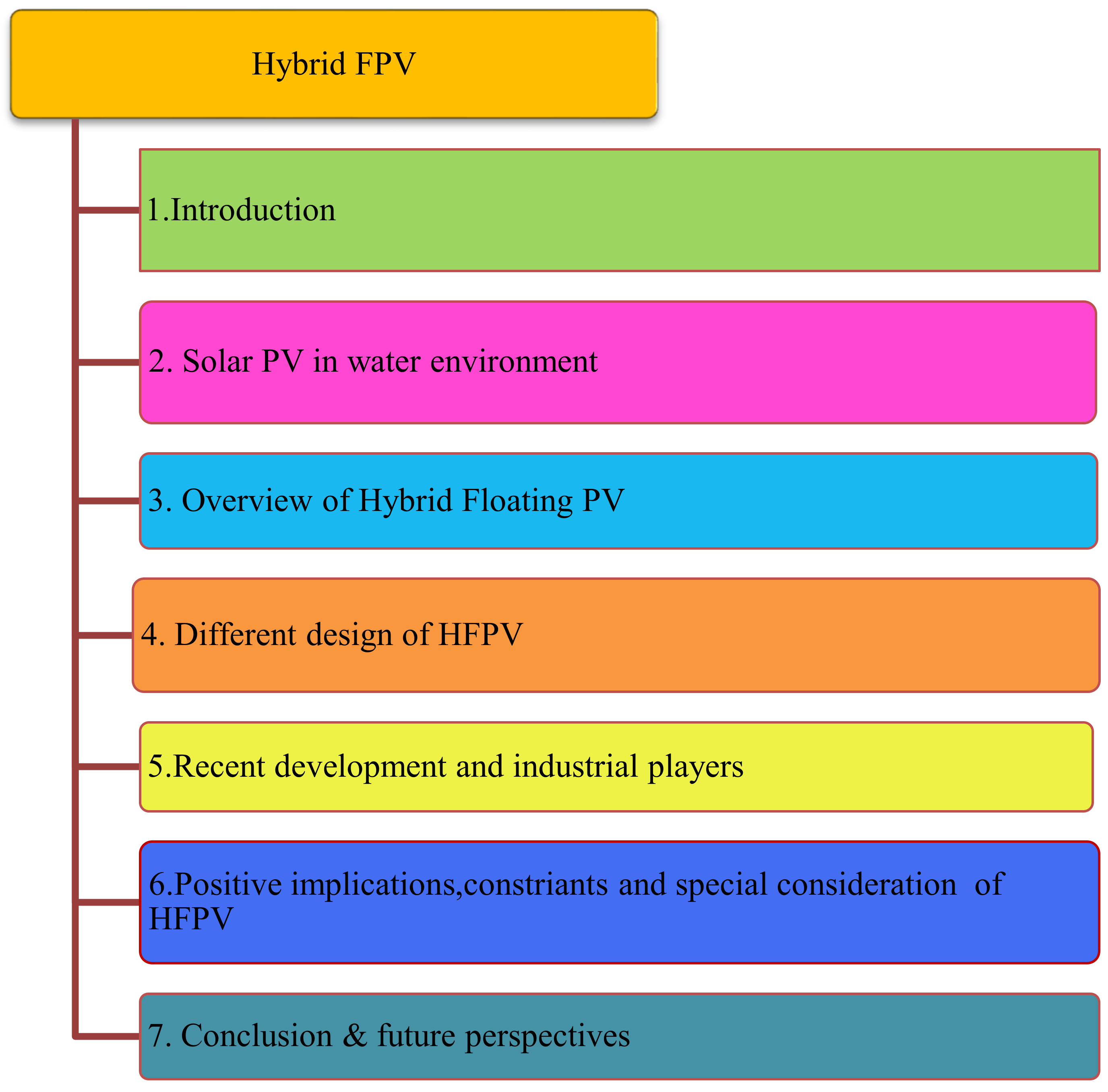




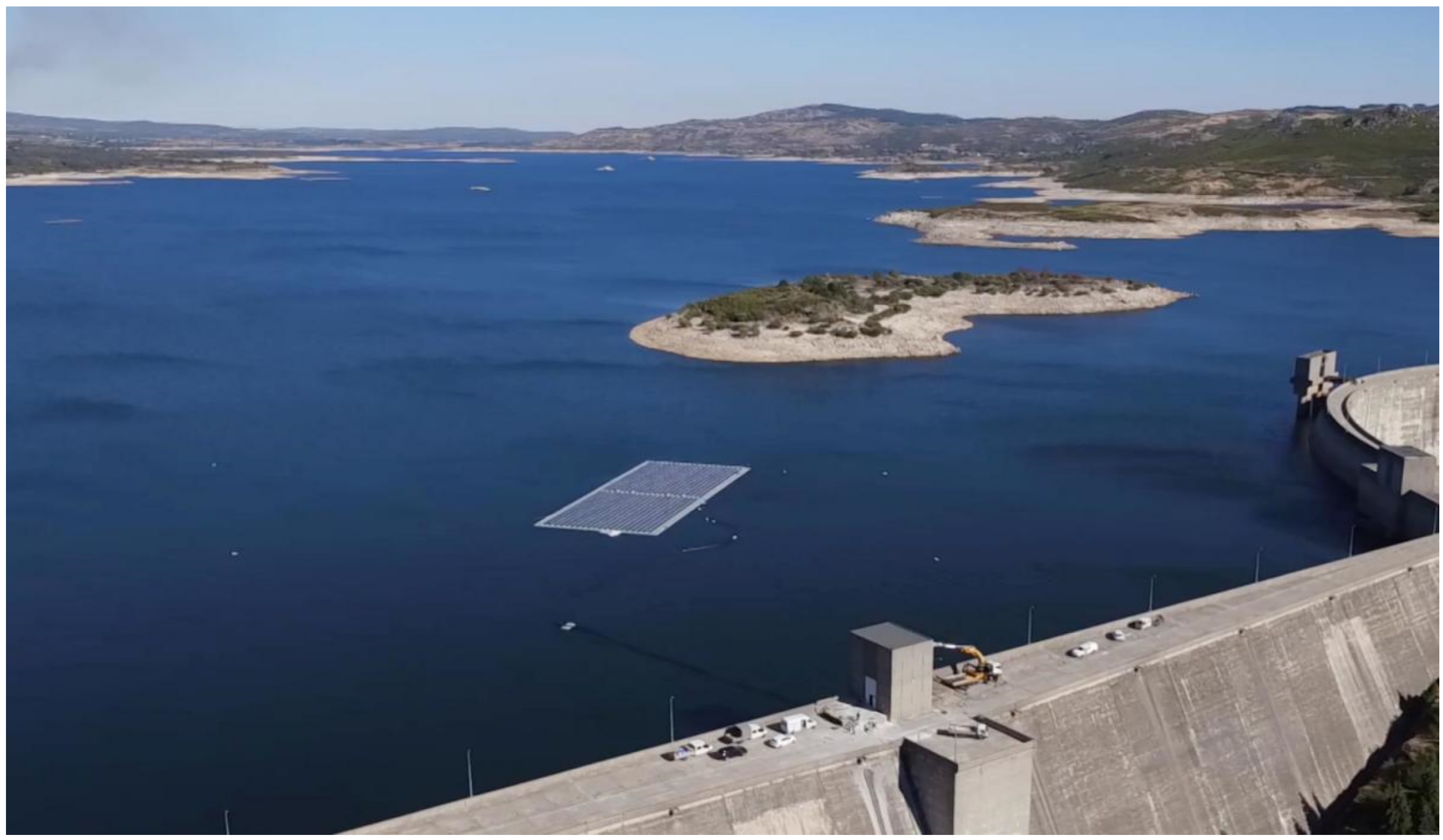



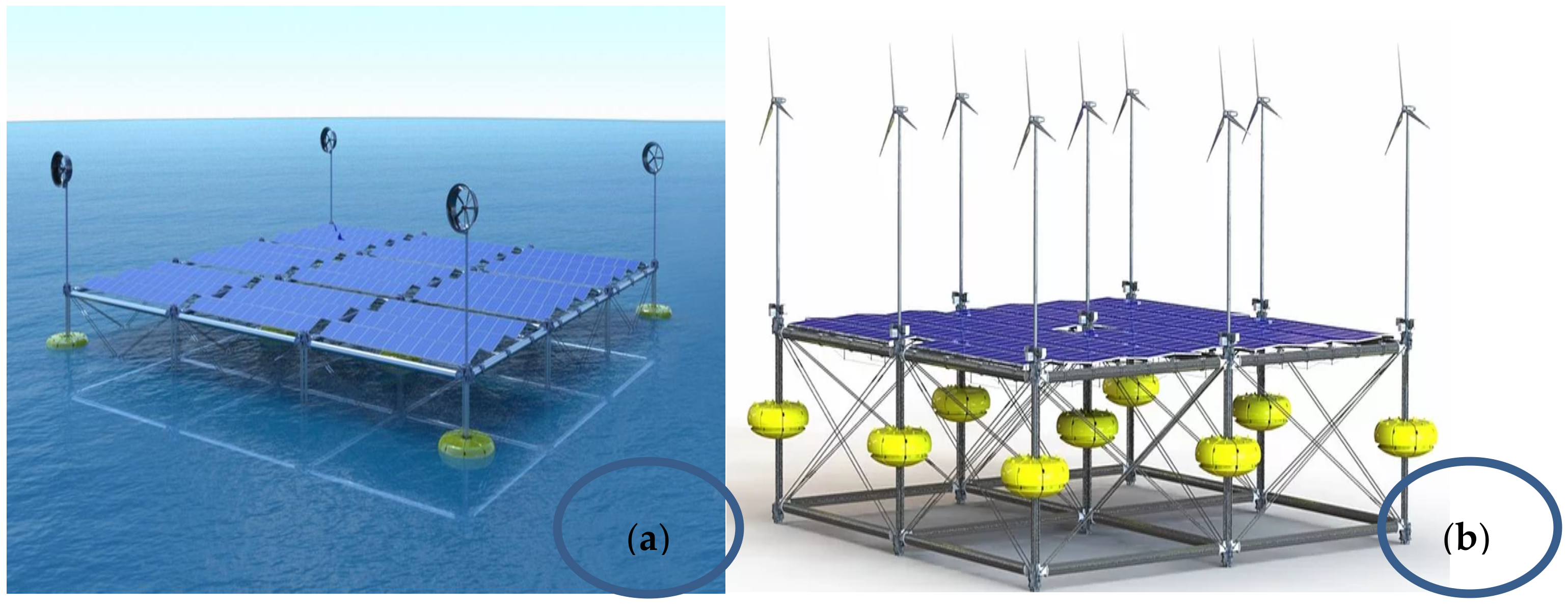
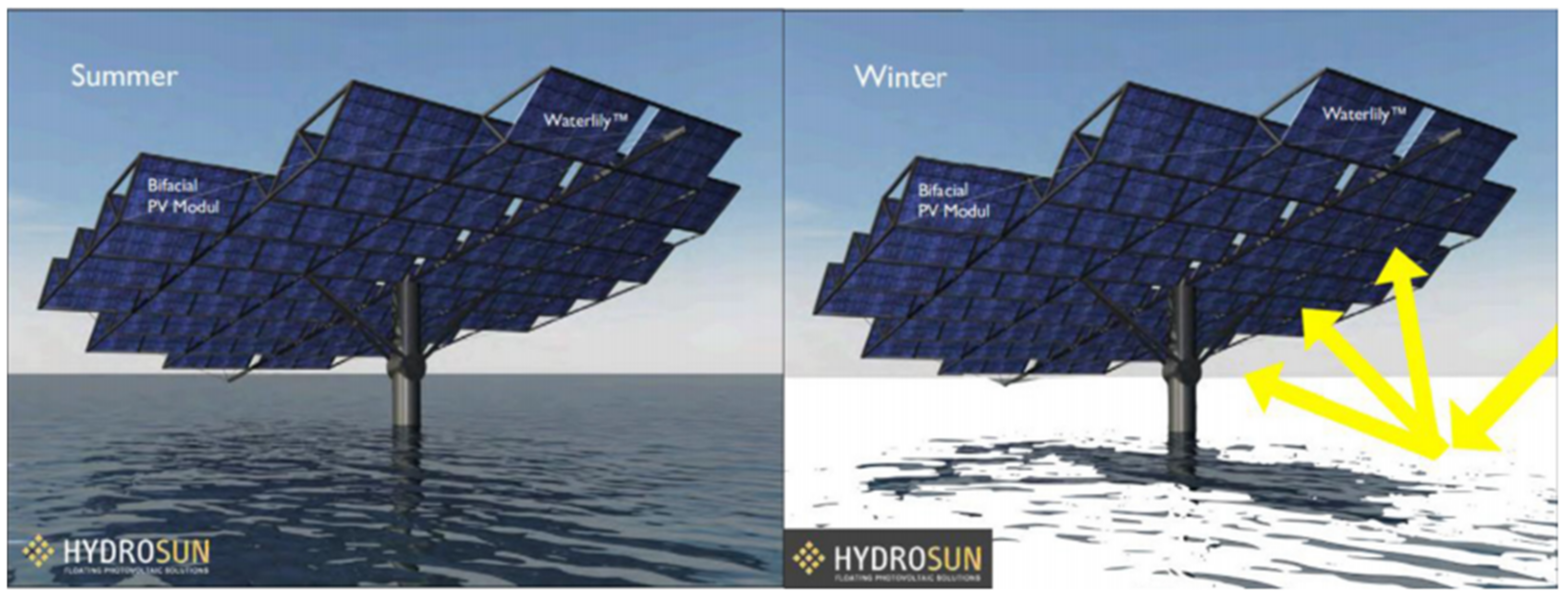
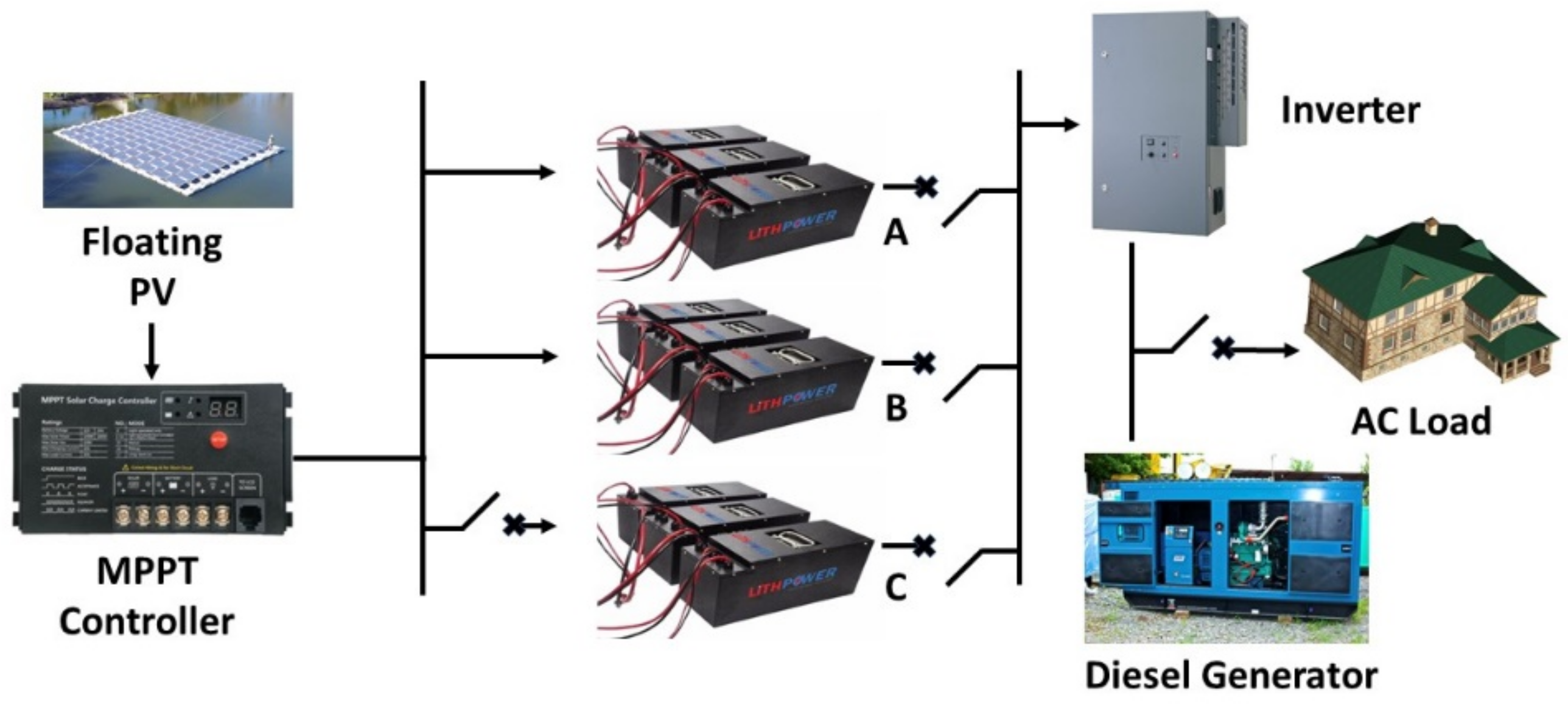
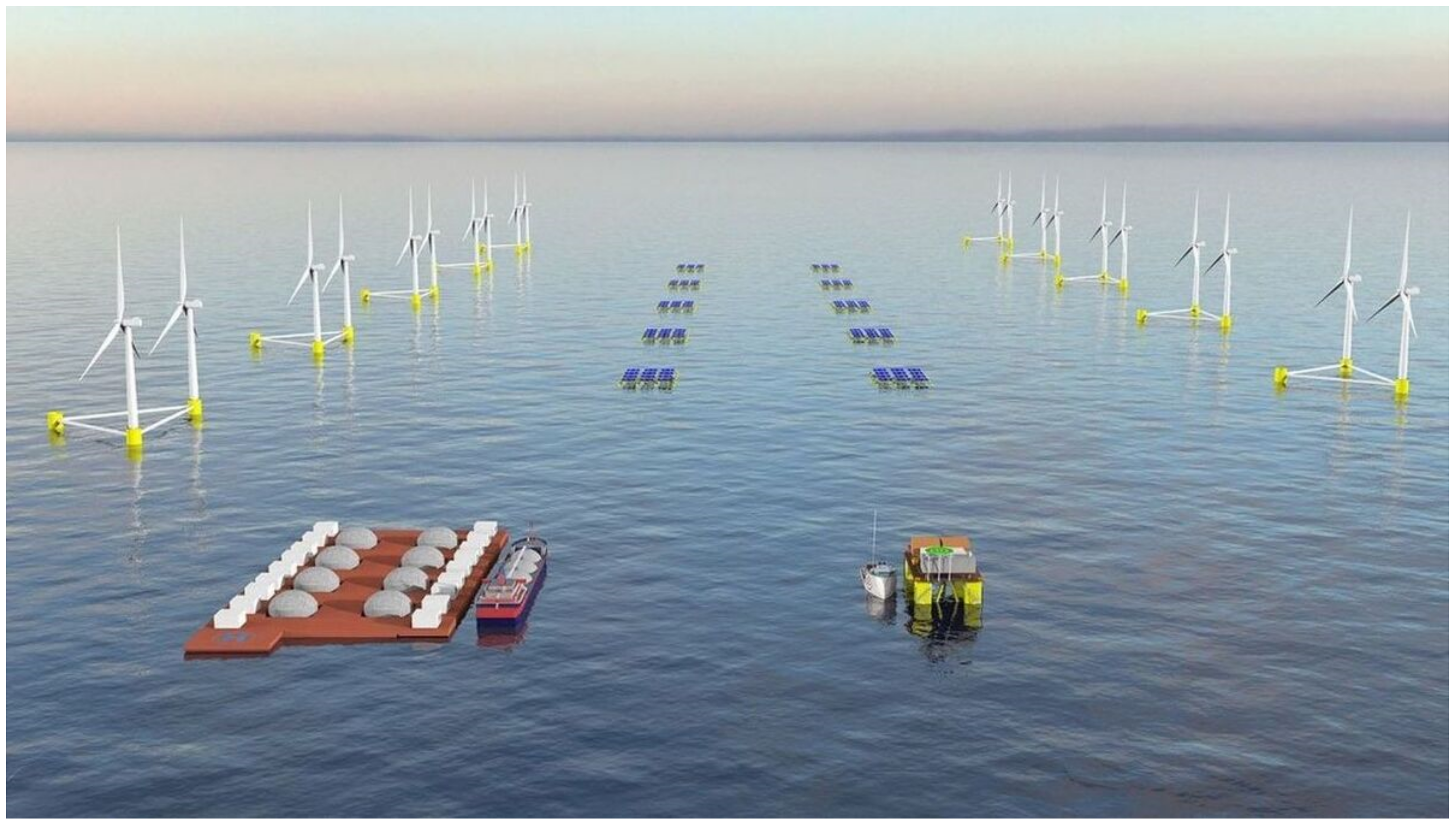


| Serial Number | Description of the Drivers |
|---|---|
| 1 | Adequate sunshine on water surface than on land. |
| 2 | Water covers two-thirds of the Earth’s surface. |
| 3 | Other energy sources like Hydropower supplies about 20% of the world’s electricity |
| 4 | Increasing cost and non-availability of land for commercial deployment |
| 5 | High land footprint and potential environmental impact with a land-based PV system |
| 6 | Low-capacity utilization of Hydropower plants and less efficiency of land-based solar PV plants |
| 7 | Specific challenges of Island nations to meet energy demand |
| 8 | The variability of energy production caused by the intermittent nature of solar |
| 9 | Problems with electrical transmission grid’s stability with one source. |
| 10 | Water-energy nexus |
| Project Name/Country | Floating Capacity | Developer/Owner | Investment/Revenue | Status |
|---|---|---|---|---|
| Sirindhom, Thailand | 45 MW | EGAT, 2020 | THB 842 million | Under construction |
| Magat, Philippines | 200 KW (360 MW hydro) | Ocean Sun, GCL-SI and SN Aboitiz Power (SNAP), 2019 | 0.4 million dollars | Pilot testing |
| Alto Rabagao, Portugal | 220 KWp (68 MW hydro) | Ciel & Terre International, 2017 | Not available (N/A) | Operational |
| Bahia, Brazil | 1 MWp (175 MW hydro) | Ciel & Terre International, 2019 | N/A | Operational |
| Banja, Albania | 2 MWp (73 MW hydro) | Ocean Sun, Statkraf | 2.61 million dollars | Under construction |
| Kutani Dam, Japan | 4.99 MWp | Japanese public enterprise agencies | 5.4 million dollars | Operational |
| Nizhne-Bureyskaya, Russia | 1.2 MW | Hevel Group and RusHydro, 2019 | N/A | Operational |
| S.No. | Industry | Technology | Product Capacity | Remarks |
|---|---|---|---|---|
| 1 | Industry group Ocean Energy Europe Floating Power Plant of Denmark, Marine Power Systems of the U.K. and Pelagic Power of Norway | Floating wind turbine platform | N/A | Conceptual stage |
| 2 | U.S.-based Excipio Energy | Integrated wind, wave, flow, and ocean thermal energy conversion technologies | 10 MW Offshore wind + 19MW other alternative energy | Yet to be tested. |
| 3 | Sinn Power Germany | Floating solar with offshore wind energy converter | 5 MW | Modular approach for underwater use |
| 4 | Cantabria Sea of Innovation Cantabria Cluster (SICC) & Acciona | Floating PV/wind with offshore green hydrogen generation | N/A | R & D project on a pilot scale |
| 5 | Equinor, Moss Maritime and Saipem | Floating offshore solar farm + Oil and gas or wind farm | 24 MW | Commercial modular design |
| 6 | Madrid based ACCIONA | Floating solar, wind, and offshore green hydrogen | N/A | R& D project on a pilot scale |
Publisher’s Note: MDPI stays neutral with regard to jurisdictional claims in published maps and institutional affiliations. |
© 2021 by the authors. Licensee MDPI, Basel, Switzerland. This article is an open access article distributed under the terms and conditions of the Creative Commons Attribution (CC BY) license (https://creativecommons.org/licenses/by/4.0/).
Share and Cite
Solomin, E.; Sirotkin, E.; Cuce, E.; Selvanathan, S.P.; Kumarasamy, S. Hybrid Floating Solar Plant Designs: A Review. Energies 2021, 14, 2751. https://doi.org/10.3390/en14102751
Solomin E, Sirotkin E, Cuce E, Selvanathan SP, Kumarasamy S. Hybrid Floating Solar Plant Designs: A Review. Energies. 2021; 14(10):2751. https://doi.org/10.3390/en14102751
Chicago/Turabian StyleSolomin, Evgeny, Evgeny Sirotkin, Erdem Cuce, Shanmuga Priya Selvanathan, and Sudhakar Kumarasamy. 2021. "Hybrid Floating Solar Plant Designs: A Review" Energies 14, no. 10: 2751. https://doi.org/10.3390/en14102751
APA StyleSolomin, E., Sirotkin, E., Cuce, E., Selvanathan, S. P., & Kumarasamy, S. (2021). Hybrid Floating Solar Plant Designs: A Review. Energies, 14(10), 2751. https://doi.org/10.3390/en14102751






